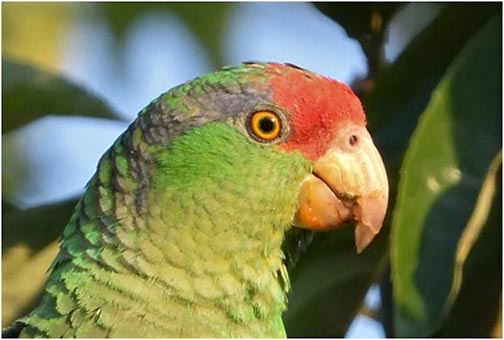
The Red-crowned parrot is distinctive with its red and blue crown. Those who take a walk during dusk or dawn in the Crescenta Valley may see and hear Red-crowned parrots, the most common parrots in the area. The Red-crowned parrot is native to northeastern Mexico. People are not sure how these birds arrived in the Crescenta Valley, but some believe that some parrots escaped from a pet store. Also, it is likely that many parrots were brought here for legal and illegal pet trade. Red-crowned parrots can be identified by their overall green coloration, deep red crown, blue nape and distinctive red wing patches seen in flight.
The first known sighting of a Red-crowned parrot in Los Angeles was in 1963, and were considered rare into the 1970s. Today, the total population locally is estimated at about 3,000 individuals, thanks to the mild climate and abundance of food from fruit trees. Although the Red-crowned parrots are thriving in Los Angeles, they are endangered in Northeastern Mexico. The estimated population in Mexico is less than 6,500 birds, down from over 100,000 birds in the 1950s.
The pet trade in Mexico is one of the largest threats to these birds. Young birds are taken out of their nests in the forest and smuggled across the border to sell as pets. Sadly, only one in five parrots survive the journey across the border.
One day, local parrots in the Crescenta Valley may be used to help repopulate their native range if the wild population in Mexico becomes extinct. Residents can help to protect Crescenta Valley parrots and other birds by keeping cats indoors since cats kill millions of birds each year, according to the Smithsonian Conservation Biology Institute. Help prevent birds from crashing into home windows by pasting paper hawks onto windows so that birds will not into fly into windows. Millions of birds die each year in window crashes, according to the U.S. Fish and Wildlife Service.
Finally, residents can help many species of birds, especially birds of prey, by not using rat poison or pesticides. If a hawk or an owl eats poisoned rats, the poison will kill these birds. Our birds are an important part of our ecosystem and need to be protected. To learn more about how to help birds, visit http://protectingourbirds.my-free.website/.
Population numbers of Red-crowned parrots were provided National Geographic Field Guide to the Birds of North America, BirdLife International and the Associated Press Article, “Parrot species in U.S. cities may rival that in native Mexico” by Julie Watson.
Contributed by Dessi SIEBURTH
Dessi Sieburth is a Montrose resident and a 10th grader at Saint Francis High School. Dessi has been interested in birding and helping birds since he was 8 years old. He created a Western Bluebird nest box project in Los Angeles, and he has presented information about protecting birds at schools, bird clubs, garden clubs, and public events.
Dessi is a volunteer at the at the Moore Lab of Zoology at Occidental College where he has conducted research on Golden-cheeked woodpeckers and Rufous hummingbirds.
Dessi was named Kid Hero for the Planet by Time for Kids Magazine in 2017.
